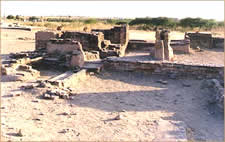|
| The
first urban civilization of the subcontinent, the Saraswati
Civilization gradually faded into the background as new
cultures emerged at the eastern and northern edges of
the Indus valley region. It took over one thousand years
for the cultural and political center of the subcontinent
to shift |
 |
from
the Sindhu valley to the middle Ganga region.The process of
change was gradual.In the absence of any written material scholars
have made various speculations regarding the causes of the decline
of the Saraswati Civilization.
Final
massacre by Aryan invaders The occurrence in the habitation
area at Mohenjo-Daro of some human skeletons including the
skull which bears a mark of a cut, has been interpreted as
evidence of a massacre at the hands of the invading Aryans.
In the later layer at Mohenjo-Daro the archeologists discovered
skeletal remains of around 38 individuals and in another house
13 adults and a single child were found while four individuals
were found in a room containing a well. The archeologists
named this as final massacre at the hands of invading Aryan
nomads.
But this view is regarded as difficult
to believe, because no evidence of any alien culture immediately
overlying the Indus one is found. This theory of Aryan invasion
tried to be made more firm, diverting the attention to the
introduction of new pottery styles, plants and animals, as
well as new foreign artifacts which represented the intrusion
of new people. The discovery of unburied skeletons combined
with uncritical interpretation of the Vedic text, has made
some scholars to claim that the decline of the civilization
was a result of the invasion or migration of indo-Aryan speaking
Vedic Aryan tribes. But there is no archeological or biological
evidence for invasion or mass migration into the Indus valley.
Recent biological studies
of human skeletal remains from northern subcontinent and central
Asia have uncovered no evidence of new populations in the
subcontinent during this time. While a limited degree of interaction
is clearly demonstrated by overlapping genetic traits that
would normally occur between adjacent population.
Heavy
flooding
Another
theory attributes the end of the civilization to heavy flooding.
There is some evidence of devastation by flood at Mohenjo-Daro
and Lothal.In the core regions of Indus and Gaggar-Hakra valley,
the wide extension of trade networks and political alliances
was highly vulnerable to relatively minor changes in the environment
and agricultural base. Due to sedimentation and tectonic movement
some water that normally would have flown into ancient Saraswati
river system, was captured by two adjacent rivers Sutlej and
Indus to the west and Yamuna of the Gangetic systems to the
east. The mounds of the Mohenjo-Daro survived because they
were slightly high. But extensive and repeated flooding combined
with shifting rivers had a devastating effect on the agricultural
foundation and economic structure of the cities.
Other
theories
Some historians are of the view that
the Saraswati Civilization like other civilizations had become
completely sterile and ossified as the time streamed by. Even
technologically it lapsed.
It is generally held that calamitous
alterations in the course of Indus and Raavi rivers led to
the desiccation of the surrounding countryside. The city of
Mohenjo-Daro became weak under the pressure of population,
which was forced to migrate. Excavations revealed that Mohenjo-Daro
was flooded more than once. Phases of at least 3 main flooding
can be detected. Chanhu-Daro was also twice destroyed by floods.
It was due to geomorphologic changes in the lower Indus region
which obstructed the normal course of irrigation leading to
the economic decline of some cities. The final blow must have
given to the civilization by a group of barbarians who began
to migrate into Bharat a little before the 2nd
millennium B.C.
|